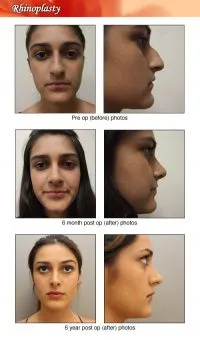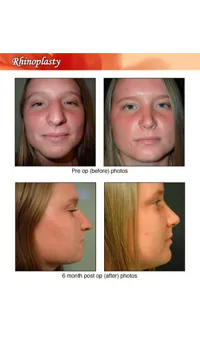Being centrally located on the face, the nose is the first feature noted after initial eye contact. And changing it can have a dramatic, if not transformative, effect. The operation that changes the shape of the nose is called a "rhinoplasty". It comes from Greek terminology. "Rhino" means "nose" and "plasty" means "to change or mold". This procedure is often sought after by those who have suffered deforming injuries, were never happy with their nose from birth or as part of a procedure to improve breathing. The nose should blend harmoniously with the other facial features and not stand out, unless it was exquisite!
The nose occupies the central mid third of the face and is roughly one eye width wide. Variations exist based upon ethnicity and gender. In general, male noses are larger, wider, higher and not as upturned as female noses. And the male bridge is usually straight or slightly convex versus the female bridge which is most pleasing with a slight concave slope.
The ideal candidate is one who is realistic in their expectations and is looking for improvement rather than perfection! Additionally, it should not be done to please someone else or in the hope of getting an acting role or recovering a lost love! It is generally done after the face is fully grown (~15 y/o for females, ~18 y/o for males), so that it is not proportionately small if the face is continuing to grow. And the best candidate is one who has a specific idea of what anatomical change they would like rather than the one who merely states that they "just don't like their nose"! And, if there is a breathing problem, it can usually addressed at the same time.
Prior to surgery, the patient is cautioned about taking certain medications and neutriceuticals that could cause bleeding (aspirin, ibuprofen, vitamin E, fish oils, et al), and is usually given such a list. Plus, alcohol and sunburns should also be avoided pre-operatively.
The procedure is performed as an outpatient in a surgi-center or hospital setting under general or twilight anesthesia. It usually takes a few hours, depending on the complexity, and may be either a "closed" or "open" approach. The difference between the two approaches is a single, imperceptible incision between the nostrils that allows the skin to be elevated off of the underlying bony-cartilaginous framework. Open rhinoplasty is most often employed in traumatic or revision cases where asymmetries can be better evaluated, difficult dissections can be accomplished from multiple vantage points and grafts can be more accurately placed and secured.
There are very few serious risks and complications with this surgery, other than the usual ones seen in any surgery such as bleeding or infection. Though not really a "complication", but an "unexpected result", might be a result falling short of one's expectation. This may be due to poor healing or not following post-op instructions, unrealistic expectations or an exaggerated result promised by the surgeon.
"Dr Pincus Explains 6 Misconceptions of a Nose Job"
There is usually nasal packing that comes out the first day after surgery. If there is a cast or sutures, these usually are removed after one week. Surprising as it may seem, there is little if any pain following the surgery. And if there is any pain, it is easily controlled with the pain medication that is prescribed. Antibiotics are also generally given because the nasal cavity can only be cleaned but not sterilized, and packing in the nose blocks the sinuses. So this helps to prevent both a nasal as well as a sinus infection. Additionally, steroids are also usually prescribed to help reduce swelling. The patient is then instructed to place cold compresses over their eyes and cheeks, intermittently for three days. Sleeping elevated is strongly encouraged to help reduce swelling. And this may be required for several weeks. If there is any bruising or swelling, it is usually resolved sufficiently after the cast comes off in one week, so that the patient may return to school or work.
Though it has been stated that the final result may not be apparent for six to twelve months, it has been my experience that one has a good idea of what the result will be within several weeks, depending on the skin thickness and amount of work needed. Obviously, this varies from surgeon to surgeon depending on their experience and technique.


